Preparing Your Vessel For an Approaching Hurricane
Planning for a hurricane may be one of the most stressful tasks a boater can face. We here at Safe/Sea thought it would be helpful if we came up with a hurricane preperation checklist to help equip boaters. As hurricanes are extremely unpredictable, there is not really a perfect plan, but taking some simple steps give you and your vessel better chances in overcoming the storm.
Before Hurricane Season Arrives:
Boats should be kept in top running condition at all times. This includes properly operating engine(s), electronics, batteries, bilge pumps, cleats, chocks, anchors & ground tackle, lines, and of course, the hull. If you are not able to personally tend to your boat during this time, arrange to have it hauled out or put another party in charge of the vessel.
If you are going to be able to tend to your vessel during hurricane season, make sure you have everything you need before hurricane season arrives. Items like spare anchors and extra lines may be in very short supply during hurricane season or just before a hurricane hits.
Storing your vessel on land:
If at all possible, the best place for a boat to be during a hurricane is on land whether on a trailer or on blocks. If you plan to store your vessel on land, there are a few things that should be checked before leaving the vessel. Check all blocks and stands to make sure they are adequate to your vessel and that your vessel appears secure on them. If possible, store your boat where it would be most sheltered from wind and possible storm surges.
Storing your vessel in the water on a mooring:
When storing your vessel on a mooring through a hurricane, you may find it helpful to follow these simple steps. First, make sure you use plenty of chafing gear. Second, make sure that the mooring line is secured to both bow cleats (if applicable). One may also find it helpful to attach a third line to the vessel's front tow eye (if applicable). Never moor the vessel by the stern.
Storing your vessel in the water on a dock:
The first thing you should do when deciding to store your boat on a dock is to make sure that the dock itself is in good condition and is secure enough to hold your vessel. Second, double up on fenders and lines and make sure that all lines have chafe gear on them where they may come in contact with another line, the boat, or the dock.
Tips that apply to everyone:
Double all lines.
Install Chafing Gear.
Plug any exhaust ports and through-hull fittings.
Remove shore power cords.
Charge all batteries.
Lower and properly secure all antennas.
NEVER LEAVE SAFE HARBOR TO RIDE OUT A STORM
*This webpage was designed as an aid to boaters. Safe/Sea does not accept any responsibility or liability for any errors or consequences of using this information.

